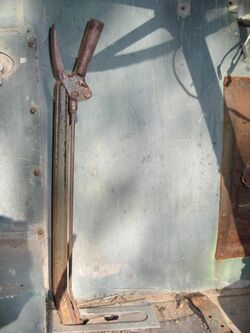Engineering:Johnson bar (vehicle)
Johnson bar is the term for several different hand-operated levers used in vehicles. Their distinguishing feature is a positive latch, typically spring-loaded, to hold the lever in a selected position, capable of being operated with one hand. Some Johnson bars have a fully ratcheting mechanism, some just a series of detents, and others yet simply engaged and disengaged positions.
A common example is the Johnson bar-controlled parking brake found on many trucks and buses.
In North America, the "Johnson bar" is the term for a lever which controls a steam locomotive's valve gear. In other countries, the term "reversing lever" is used.[1][2]
The forward/reverse lever on Caterpillar tractors is also called a Johnson bar.
Some light general aviation aircraft (including Piper Cherokees, Beech Musketeers, and some early model Cessnas – such as the Cessna 140) - use Johnson bars to actuate flaps and wheel brakes. The Cessna 162 Skycatcher uses a Johnson bar for flap operation. A small number of older aircraft (including the Mooney M-18, some older M20s and some Progressive Aerodyne SeaReys) also have landing gear actuated by Johnson bars. The Boeing 707/720 aircraft had a Johnson bar for manually extending the nose landing gear, in case the normal gear extension failed.[citation needed]
See also
References
 |


